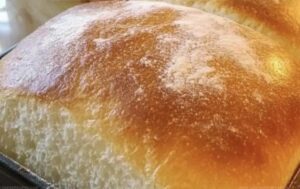Description
Homemade “white bread from scratch” brings warmth and comfort straight from your kitchen’s heart. Fresh ingredients and simple techniques combine to create a classic loaf that connects family and tradition with each delicious slice you’ll savor.
Ingredients
Scale
Main Dry Ingredients:
- 5.5 to 6 cups all-purpose flour
- 2.25 teaspoons (1 packet) active dry yeast
- 2 tablespoons granulated sugar
- 1.5 teaspoons salt
Liquid Ingredients:
- 0.25 cup unsalted butter, melted
- 2 cups warm water (about 110°F/45°C)
Finishing Ingredient:
- Extra melted butter (for brushing loaves)
Instructions
- Prepare the yeast catalyst by whisking warm water, sugar, and active dry yeast in a petite vessel. Allow the mixture to bloom and become frothy, indicating the yeast’s vitality, which typically takes 5-10 minutes.
- In a capacious mixing receptacle, amalgamate flour and salt. Incorporate the effervescent yeast solution and melted butter, stirring until a cohesive, slightly tacky dough emerges.
- Methodically integrate the remaining flour, kneading persistently until the dough transforms into a smooth, elastic texture. This process demands approximately 8-10 minutes of manual manipulation or 5 minutes with a mechanical mixer.
- Transfer the developed dough into a lightly greased container, ensuring complete surface coverage. Drape with a pristine cloth and position in a temperate environment, permitting the dough to expand and double in volume within 1-1.5 hours.
- Deflate the risen dough by pressing down firmly. Segment into two uniform portions, meticulously sculpting each into a loaf-like configuration. Nestle these formations into greased 9×5-inch baking vessels.
- Envelop the pans, allowing the dough to undergo a secondary expansion until it crests approximately 1 inch above the pan’s rim, typically requiring 30-45 minutes.
- Calibrate the oven to 375°F (190°C). Position the loaves and bake until the surfaces achieve a golden-bronze hue and emit a hollow resonance when gently tapped, approximately 25-30 minutes.
- Enhance the crust’s tenderness by delicately brushing with liquefied butter. Allow the loaves to rest within the pans for 10 minutes before transferring to a wire cooling platform, ensuring complete temperature stabilization prior to slicing.
Notes
- Warm water temperature matters critically for yeast activation; aim for 110-115°F to ensure proper proofing without killing the yeast.
- Humidity and flour brand can affect dough consistency, so adjust flour quantity gradually and learn to feel the right dough texture.
- Kneading develops gluten networks, creating bread’s signature chewy structure; longer kneading produces a more refined, lighter loaf.
- For gluten-free variation, swap wheat flour with a blend of rice, potato, and tapioca starch, adding xanthan gum for binding.
- Prep Time: 20 minutes
- Cook Time: 30 minutes
- Category: Breakfast, Snacks, Dinner
- Method: Baking
- Cuisine: American
Nutrition
- Serving Size: 2
- Calories: 280
- Sugar: 2 g
- Sodium: 300 mg
- Fat: 8 g
- Saturated Fat: 5 g
- Unsaturated Fat: 3 g
- Trans Fat: 0 g
- Carbohydrates: 48 g
- Fiber: 2 g
- Protein: 7 g
- Cholesterol: 15 mg
